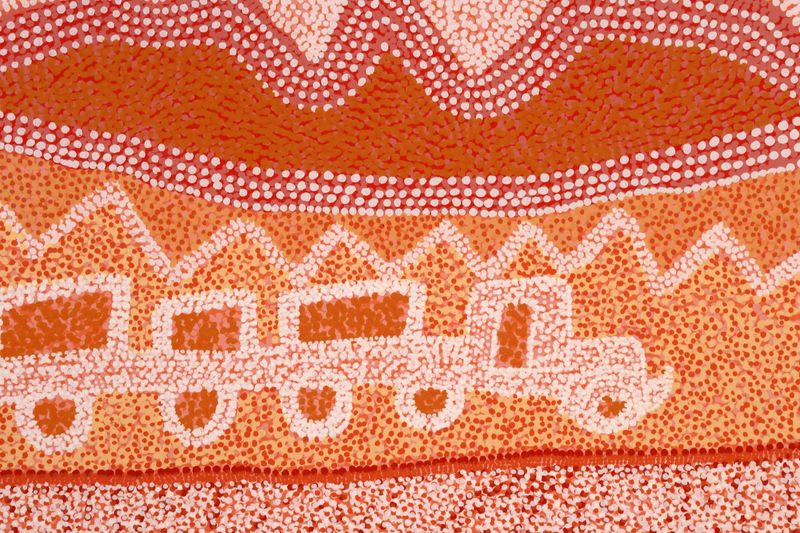Jimmy Pike
"My work is painting and drawing, telling stories from the Dreamtime and about places where Dreamtime people travelled through my country. They set down the Law for real people today, wherever they are. Thats what I paint"
Aboriginal artist, Jimmy Pike (also known as Jimmy Kurtnu Pike), lived in a bush camp on the edge of the remote Great Sandy Desert of north Western Australia where he painted, producing art for which he has become so well known.
Jimmy was born in 1940, east of Japingka, in remote sandhill country in the north of Western Australia. He was a member of the Walmajarri people, his Walmajarri name is Kurnti Kujarra, and was one of the last groups to leave the desert and settle near one of the sheep and cattle stations in the river valleys of the Kimberley during the 1950’s.
His early childhood was a nomadic life moving with his family around the various waterholes that were the focal points of their arid country. This traditional lifestyle in the Great Sandy Desert country, with its ancient culture and symbols are the things that inspired Jimmy Pike’s work. Then in his early teens he went to live at Cherrabun Station, one of a number of sheep and cattle stations in the river valleys of the Kimberley, where he worked as a stockman. It was the white station owner manager that gave him the name of Jimmy Pike, after the champion jockey who rode Phar Lap.
As a young man, Pike got into strife when alcohol entered his life. He was jailed for a string of minor offences, then convicted in 1980 for a man’s murder – his involvement in what was a tribal murder. Sent to Fremantle Prison, Pike met two young art teachers who worked with prisoners, Stephen Culley and print-maker David Wroth. His natural talent astonished them - taking a pile of linocut squares into his cell overnight, he emerged with superb black-and-white images that would later end up in the National Gallery of Australia in Canberra.
Wroth recalls: “Jimmy basically said, ‘Give me three of those lino blocks’, took them off and came back the next day with the most astonishing prints I’d seen, with all the raw energy of European expressionist painters. He didn’t need me to teach him; he’d done a lot of wood carving and was very skilled, so he used the cutting tool in the way he would a penknife through wood, cutting left then right in a zigzag fashion. His lines had that jagged look that gave them life.”
Pike’s work was now attracting interest and in collaboration with Wroth and Culley who formed Desert Designs and opened a gallery space with a business partner Ian Plunkett, soon saw his prints turned into fabric designs for clothing ranges in Japan, Europe and the US.
Jimmy Pike’s paintings from the 1980s and 1990s showed the physical and spiritual quality of his traditional Walmajarri country, and added a new dynamism to the central positions of landscape in Australian art. The artist’s themes of the intricacies of desert landscape, the visual character of the changing seasons and the particularities of its Aboriginal spirituality have transformed this extremely isolated area of the northern part of Australia into a tangible experience.
“My work is painting and drawing, telling stories from the Dreamtime and about places where Dreamtime people travelled through my country. They set down the Law for real people today, wherever they are. Thats what I paint”
A few years later he set up his isolated camp in the desert where he painted until his death in 2002. He worked in the open, resting his paintings on a rough work table he made from old planks. He stored his art and other materials under a heavy canvas fly, where he also took refuge from the rare seasonal falls of rain.
Pike was both a painter and printmaker, telling traditional stories through the use of dual and aerial perspective. He used bold graphic lines and solid blocks of intense, often fluorescent colour. Other works were bold monochromatic prints, his works challenging stereotypes of Aboriginal art and the assumptions that the desert was bleak and lifeless. Jimmy Pike is represented in the collections of major Australian public galleries and museums.

